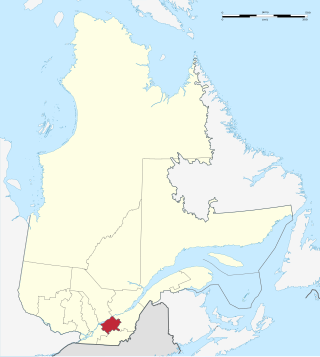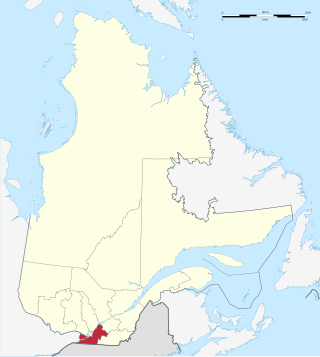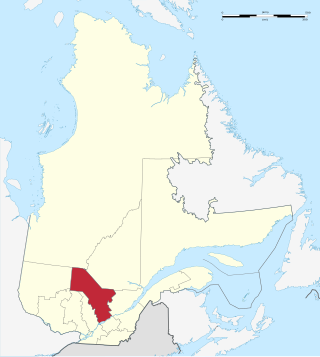
Nord-du-Québec is the largest, but the least populous, of the seventeen administrative regions of Quebec, Canada. With nearly 750,000 square kilometres (290,000 sq mi) of land area, and very extensive lakes and rivers, it covers much of the Labrador Peninsula and about 55% of the total land surface area of Quebec, while containing a little more than 0.5% of the population.

Saguenay–Lac-Saint-Jean is a region in Quebec, Canada. It contains the Saguenay Fjord, the estuary of the Saguenay River, stretching through much of the region. It is also known as Sagamie in French, from the first part of "Saguenay" and the last part of "Piekouagami", the Innu name for Lac Saint-Jean, with the final "e" added to follow the model of other existing region names such as Mauricie, Témiscamie, Jamésie, and Matawinie. With a land area of 98,712.71 km2, the Saguenay–Lac-Saint-Jean is, after the Nord-du-Québec and Côte-Nord regions, the third-largest of Quebec regions in the area.

Centre-du-Québec is a region of Quebec, Canada. The main centres are Drummondville, Victoriaville, and Bécancour. It has a land area of 6,930.05 square kilometres (2,675.71 sq mi) and a 2016 Census population of 242,399 inhabitants.

Montérégie is an administrative region in the southwest part of Quebec. It includes the cities of Boucherville, Brossard, Châteauguay, Longueuil, Saint-Hyacinthe, Saint-Jean-sur-Richelieu, Salaberry-de-Valleyfield and Vaudreuil-Dorion.

Montréal is one of the administrative regions of the Canadian province of Quebec. It is also a territory equivalent to a regional county municipality (TE) and a census division (CD), for both of which its geographical code is 66. Prior to the merger of the municipalities in Region 06 in 2002, the administrative region was co-extensive with the Montreal Urban Community.

Mauricie is a traditional and current administrative region of Quebec. La Mauricie National Park is contained within the region, making tourism in Mauricie popular. The region has a land area of 35,860.05 km² and a population of 266,112 residents as of the 2016 Census. Its largest cities are Trois-Rivières and Shawinigan.

Capitale-Nationale is one of the 17 administrative regions of Quebec. It is anchored by the provincial capital, Quebec City, and is largely coextensive with that city's metropolitan area. It has a land area of 18,797.45 km2. It reported a total resident population of 729,997 as of the Canada 2016 Census, with Quebec City having 73.7 percent of the total.
The Canadian province of Quebec held municipal elections in its municipalities on November 6, 2005.
Health regions, also called health authorities, are a governance model used by Canada's provincial and territorial governments to administer and deliver public health care to all Canadian residents.
These are lists of people from Quebec by region.

The Province of Quebec is divided into entities that deliver local government, along with other types of functional divisions.

The urban agglomeration of Longueuil was created on January 1, 2006 as a result of the de-amalgamation process brought upon by the Charest government. It encompasses all the boroughs that were merged into the previous city of Longueuil and still retains the same area as that mega-city.
A regional conference of representatives was a type of governance in an administrative region of Quebec.
The Rivière aux Castors Noirs is a tributary of the Batiscan River, flowing in Haute-Batiscanie, in the province of Québec, Canada. This watercourse crosses:
The Rivière Écartée is a tributary of the Bras du Nord, flowing in the territory of the municipality of Saint-Raymond, in the Portneuf Regional County Municipality, in the administrative region of Capitale-Nationale, in Quebec, Canada.
A regional park, in Québec, is an area designated by a regional county municipality (MRC), or equivalent territory, for the dual purposes of recreation and promoting of nature conservation.









